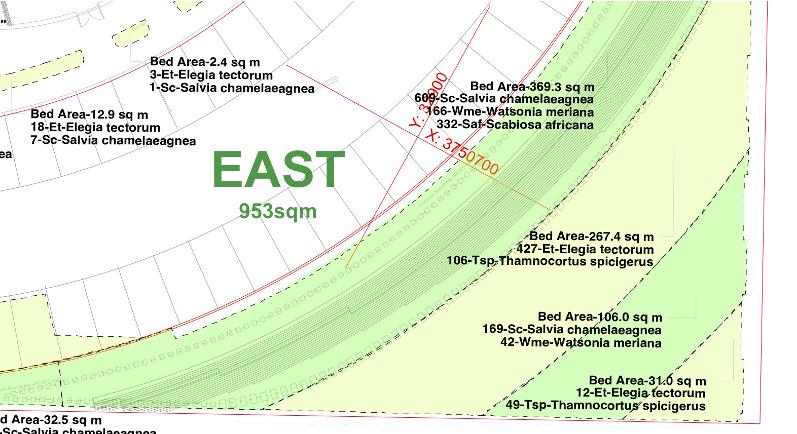Bloemhof EHQ: Planting Details
The Bloemhof planting designs employed a relatively short list of endemic fynbos and renosterveld species found locally with the exception of the Canary Island Date Palms used as an extension of the cultural landscape.
The planting designs are subtle yet simple and are created using combinations of either 2 or 3 of the selected species. This creates a strong unified image at the same time as allowing natural looking mixes of the theme plants. Each bed is planted with its own percentage mix of the different plants.
The result of this planting design method has been highly successful allowing an artful arrangement of indigenous species well suited to the area and not requiring irrigation after establishment. The mix of three species is preferable generally except in smaller or narrower beds where 2 species were mixed.
The mixes included restios (Cape Reeds), shrubs (blue sage, crossberries/taaibos), bulbs (Watsonias), composites/daisies (renosterbos and wild rosemary) and some groundcovers (Gazania and Crassula).
Shadier locations of necessity used shade-loving forest species from the SW Cape, notably, bush lilies (Clivia).
The theme shade tree used in the car parks and roof garden was the wild olive with accents of wild peach all found locally.
The same species were used throughout both in natural ground, retaining wall blocks, planters and roof gardens.
The scheme's requirement to satisfy its Green Star rating meant 90% irrigation reduction. This was simply achieved by only irrigating building planters which were about 10% of the landscape area. The remaining landscape was hand watered as needed in the first two summers which are very hot and dry in the Cape.
Special additives were used in the site soil to improve water retention and a thick mulch (50mm) of bark chip was used to help retain water in the soil. This was also found to be very effective in reducing erosion in the early establishment phase. Where some erosion occurred on slopes, bidim 'bandages' 500mm wide were laid down areas tending to form gullies. This only happened in the first season whereafter the soil stabilised by compaction and root growth.
The use of natural planting has seen the return of local birdlife to the scheme which once was devoid of anything but the most common garden varieties. When looking out from the roof tops over the naturally planted areas the connection to the nearby Tygerberg Hills is well coordinated blending beautifully with the natural environment.
Although experimental as a way of designing bedding this method has proved highly successful and could be adapted to higher species richness quite easily by using 4 or 5 species per bed instead of the 2 or 3 used here.

Driveway planting featuring Canary Island Date Palms and formal fynbos species

Main landscape area on a large berm featuring bands of intermixed planting

Formal planting around the waterfall features using restio and hedging species

An outlying corner of radial planting using mixes of the endemic species
COPYRIGHT WARNING: All images and text on this site are Copyright © NWA and may not be reproduced without the written permission and acknowledgement of New World Associates.